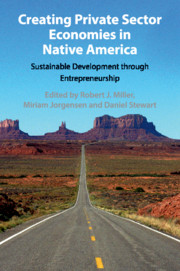 Creating Private Sector Economies in Native America
Creating Private Sector Economies in Native America from Part IV - From Learning to Doing: Examples of Entrepreneurship in Indian Country
Published online by Cambridge University Press: 15 October 2019
In many Native communities, an understanding of the critical role that artists and culture bearers can play in building vibrant economies has yet to take hold, and many emerging artists live on less than $10,000 per year. First Peoples Fund (FPF) was founded on the understanding that investing in artists makes economic sense for tribal communities; with adequate support, they can become viable economic engines and social change-makers. FPF’s initial grant programs supported individual artists and helped build their business skill sets. These programs were highly successful, but the FPF wanted board and staff to make larger and more lasting change. Through research, reflective learning, and enhanced programming and partnerships, FPF developed an expanded investment model based on the knowledge that when relationships between community organizations and artists are woven more tightly together, the entire local arts ecosystem is strengthened, allowing the “Indigenous arts ecology” to thrive and improving the economic and cultural lives of artists, their families, and communities.
To save this book to your Kindle, first ensure [email protected] is added to your Approved Personal Document E-mail List under your Personal Document Settings on the Manage Your Content and Devices page of your Amazon account. Then enter the ‘name’ part of your Kindle email address below. Find out more about saving to your Kindle.
Note you can select to save to either the @free.kindle.com or @kindle.com variations. ‘@free.kindle.com’ emails are free but can only be saved to your device when it is connected to wi-fi. ‘@kindle.com’ emails can be delivered even when you are not connected to wi-fi, but note that service fees apply.
Find out more about the Kindle Personal Document Service.
To save content items to your account, please confirm that you agree to abide by our usage policies. If this is the first time you use this feature, you will be asked to authorise Cambridge Core to connect with your account. Find out more about saving content to Dropbox.
To save content items to your account, please confirm that you agree to abide by our usage policies. If this is the first time you use this feature, you will be asked to authorise Cambridge Core to connect with your account. Find out more about saving content to Google Drive.